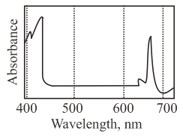The three types of photosynthetic pigments in higher plants are
Important Questions on Photosynthesis in Higher Plants
A) Chlorophyll is the major pigment responsible for the trapping of light, accessory pigments also participate
B) In green plants, H2O is the hydrogen donor
C) In purple sulfur bacteria the oxidation product is carbon
D) Radioisotope studies proved water as a source of O2 release in photosynthesis.
I. has high affinity to oxygen in low concentration.
II. The Calvin pathway occurs in the chloroplast of bundle sheath cells of plants.
III. Yeast position themselves when the concentration of alcohol reaches .
IV. Oxygen is a final hydrogen acceptor during aerobic respiration.
Assertion (A): Chromatographic separation of leaf pigments shows that leaves has four different pigments.
Reason (R): Pigments absorb light at specific wavelengths and help in the process of photosynthesis. The major leaf pigments are chlorophyll-a, chlorophyll-b, xanthophylls and carotenoids.
The correct option among the following is:
Assertion In , the reaction centre, chlorophyll 'a' has an absorption peak at , hence is called , while in , it has absorption maxima at and is called .
Reason Calvin pathways occur in all photosynthetic plants, it does not matter where they have or pathways and the Calvin cycle described in three stages: Carboxylation, reduction and regeneration.
The correct answer is:
Arrange the path of electrons from water to the phycocyanin in the light reaction.
i) Plastoquinone
ii) Excited
iii) Cyt
iv)
v) Pheophytin
vi) Quinone
The correct sequence is
The graph below represents the absorption spectrum of a major pigment contributing to photosynthesis.

Which one of the following best represents the photosynthetic efficiency of the pigment?

